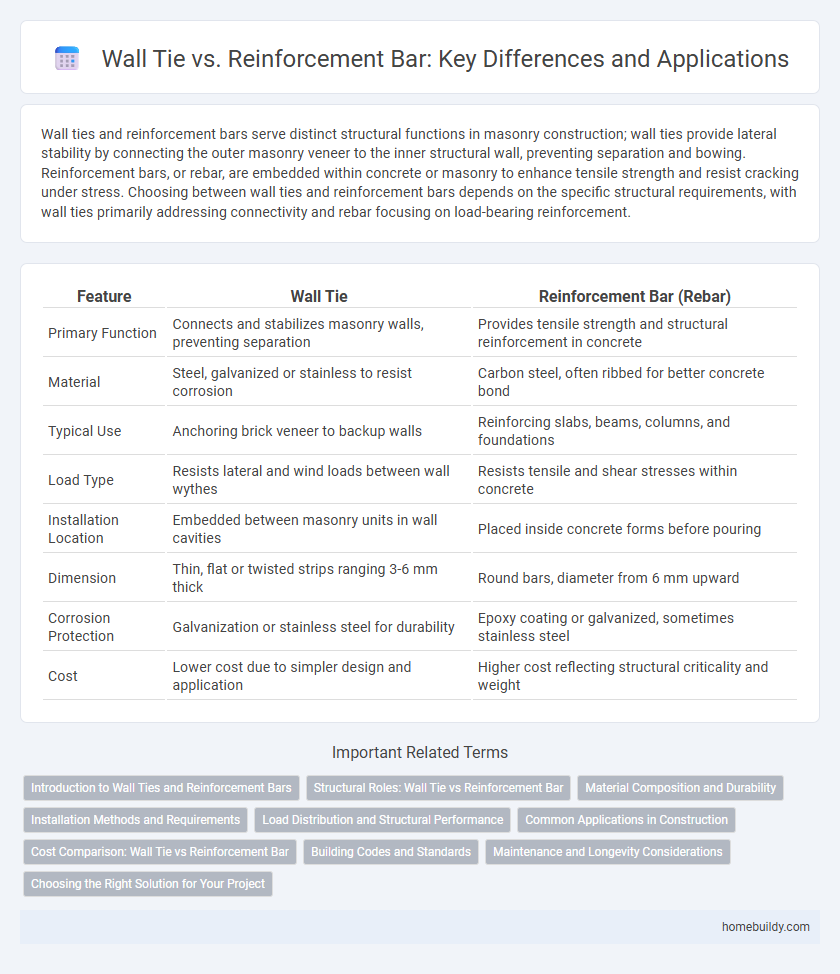Wall ties and reinforcement bars serve distinct structural functions in masonry construction; wall ties provide lateral stability by connecting the outer masonry veneer to the inner structural wall, preventing separation and bowing. Reinforcement bars, or rebar, are embedded within concrete or masonry to enhance tensile strength and resist cracking under stress. Choosing between wall ties and reinforcement bars depends on the specific structural requirements, with wall ties primarily addressing connectivity and rebar focusing on load-bearing reinforcement.
Table of Comparison
| Feature | Wall Tie | Reinforcement Bar (Rebar) |
|---|---|---|
| Primary Function | Connects and stabilizes masonry walls, preventing separation | Provides tensile strength and structural reinforcement in concrete |
| Material | Steel, galvanized or stainless to resist corrosion | Carbon steel, often ribbed for better concrete bond |
| Typical Use | Anchoring brick veneer to backup walls | Reinforcing slabs, beams, columns, and foundations |
| Load Type | Resists lateral and wind loads between wall wythes | Resists tensile and shear stresses within concrete |
| Installation Location | Embedded between masonry units in wall cavities | Placed inside concrete forms before pouring |
| Dimension | Thin, flat or twisted strips ranging 3-6 mm thick | Round bars, diameter from 6 mm upward |
| Corrosion Protection | Galvanization or stainless steel for durability | Epoxy coating or galvanized, sometimes stainless steel |
| Cost | Lower cost due to simpler design and application | Higher cost reflecting structural criticality and weight |
Introduction to Wall Ties and Reinforcement Bars
Wall ties are crucial for connecting outer masonry walls to inner structural frames, providing lateral stability and preventing wall separation under load. Reinforcement bars, commonly known as rebars, are steel rods embedded in concrete to enhance tensile strength and resist cracking under tension. Unlike reinforcement bars that strengthen concrete elements, wall ties primarily maintain the integrity of masonry cavity walls by ensuring uniform load distribution and structural cohesion.
Structural Roles: Wall Tie vs Reinforcement Bar
Wall ties primarily serve to connect and stabilize masonry walls by transferring lateral loads and preventing separation between wythes, ensuring structural integrity against wind and seismic forces. Reinforcement bars (rebar) provide tensile strength within concrete, enhancing load-bearing capacity and resisting bending, shear, and tension stresses in structural elements. While wall ties maintain alignment and cohesion of masonry units, reinforcement bars fundamentally improve the tensile and flexural resilience of concrete structures.
Material Composition and Durability
Wall ties are typically made from galvanized steel or stainless steel to resist corrosion, while reinforcement bars (rebar) are usually composed of carbon steel with ribbed surfaces for enhanced bonding with concrete. The corrosion-resistant materials in wall ties ensure long-term durability in masonry structures exposed to moisture, whereas rebar's primary durability relies on concrete's protective environment to prevent rusting. Material composition significantly influences the lifespan of wall ties and reinforcement bars, affecting structural integrity over time.
Installation Methods and Requirements
Wall ties require precise spacing and embedment within masonry joints to ensure structural stability, typically installed during bricklaying with corrosion-resistant materials. Reinforcement bars are embedded in concrete or grout, requiring accurate placement tied with wire or supported by chairs to maintain position during pouring. Proper installation of both elements is critical for load distribution and preventing wall failure.
Load Distribution and Structural Performance
Wall ties primarily function to connect masonry wythes, ensuring effective load distribution by transferring lateral forces and enhancing wall stability, while reinforcement bars (rebars) provide tensile strength and resist bending stresses within concrete structures. Unlike reinforcement bars that improve overall structural performance by handling tensile loads, wall ties optimize shear load distribution between wythes, preventing separation and improving collective behavior under lateral forces. The synergy of wall ties and reinforcement bars enhances both load distribution and structural integrity in masonry and concrete assemblies.
Common Applications in Construction
Wall ties are commonly used to connect the inner and outer walls in cavity wall construction, providing stability and preventing separation. Reinforcement bars, or rebars, are embedded in concrete structures to enhance tensile strength and resist bending forces in beams, columns, and slabs. While wall ties maintain wall alignment in masonry, rebars are essential for structural integrity in reinforced concrete applications.
Cost Comparison: Wall Tie vs Reinforcement Bar
Wall ties generally offer a more cost-effective solution compared to reinforcement bars, especially in masonry construction where they secure cavity walls at a lower material and labor expense. Reinforcement bars, while providing superior tensile strength and structural integrity, often come with higher costs due to material prices and installation complexity. Selecting wall ties optimizes budget allocation in non-load-bearing applications, whereas reinforcement bars justify their cost in high-stress structural elements.
Building Codes and Standards
Wall ties and reinforcement bars serve distinct roles governed by building codes and standards such as the International Building Code (IBC) and ASTM specifications. Wall ties are primarily designed to connect and stabilize masonry veneer to backup walls, ensuring structural integrity against lateral forces, while reinforcement bars provide tensile strength within concrete elements, essential for load-bearing capacity. Compliance with codes like ACI 318 ensures proper installation criteria for both components, enhancing overall building safety and durability.
Maintenance and Longevity Considerations
Wall ties require less frequent maintenance compared to reinforcement bars due to their corrosion-resistant materials like stainless steel or galvanized metal. Reinforcement bars, often embedded in concrete, are prone to rusting over time if moisture penetrates, leading to potential structural weaknesses. Prioritizing wall ties in construction can enhance the longevity of masonry walls by minimizing corrosion-related deterioration and easing long-term upkeep.
Choosing the Right Solution for Your Project
Wall ties provide structural stability by connecting masonry walls to supporting frameworks, ideal for resisting lateral forces in cavity walls. Reinforcement bars (rebar) enhance tensile strength within concrete, crucial for load-bearing elements requiring significant durability. Selecting the right solution depends on the specific structural requirements, environmental conditions, and the intended load distribution of your construction project.
Wall tie vs Reinforcement bar Infographic

 homebuildy.com
homebuildy.com